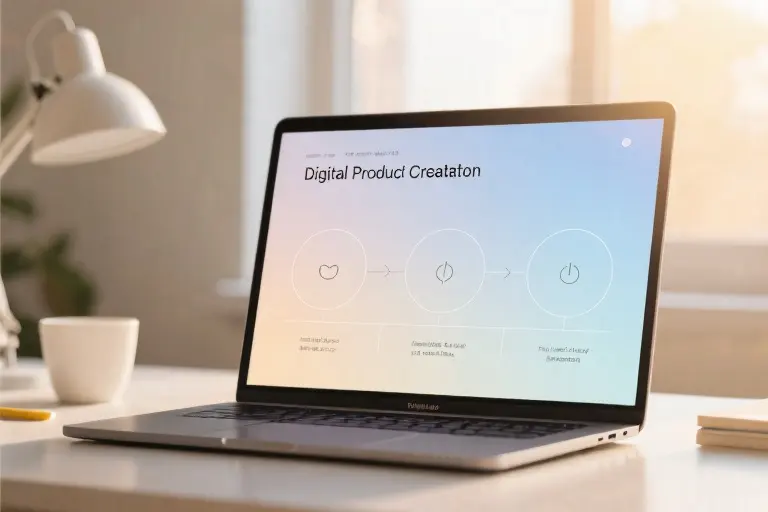Back in 2018, I uploaded my first online course to Udemy with trembling hands and sky-high expectations. Three months later, the revenue report showed barely enough earnings to cover my coffee habit. That initial disappointment became my most valuable business education – not because of the money (or lack thereof), but because those imperfect first attempts taught me something most creators never discover: starting before you’re ready is the fastest path to monetizing your knowledge.
What I’ve learned from coaching thousands of writers and creators since then is that we all share the same dangerous misconceptions about digital products:
- The Audience Myth: “I need at least 10,000 followers before I can sell anything”
- The Perfection Trap: “This isn’t good enough yet – maybe after one more revision”
- The Tool Obsession: “If I just buy that $297 course creation software first…”
Here’s what no one tells you about monetizing your expertise: Digital products are the ultimate equalizer. While my early Udemy courses made pennies, they proved something revolutionary – you don’t need permission, polish or a platform to start earning. That $7 PDF guide you’ve been hesitating to create? Someone would gladly pay for it tomorrow. That 3-day email course you think is too simple? It’s exactly what your ideal customer needs right now.
The most successful creators I know share one counterintuitive habit: they treat their first digital product like a prototype rather than a masterpiece. My $2,000 coaching program exists today because I allowed myself to launch those embarrassingly rough Udemy courses years ago. Every lesson learned from those early buyers became fuel for better products down the road.
What makes digital products uniquely powerful is their ability to generate freedom on your terms. Unlike physical goods requiring inventory or services demanding your constant time, a well-designed digital asset can:
- Be created during your morning writing session
- Sell to customers in different time zones while you sleep
- Scale beyond your personal capacity
That “today created → tomorrow selling → 24-hour revenue” reality isn’t just possible – it’s happening right now for creators who’ve broken through the three myths holding you back. The only difference between them and you? They started before feeling ready.
Remember: Every $2,000 product begins as a $7 experiment. The question isn’t whether you’re qualified to monetize your knowledge – it’s whether you’re willing to learn through action rather than hesitation.
Why You’re Hesitating to Monetize Your Knowledge
Let me guess: you’ve been sitting on that brilliant idea for months, maybe even years. You tell yourself you’ll create that ebook or online course “when the time is right” – when you have more followers, when your website looks perfect, when you’ve bought that fancy equipment. Sound familiar?
The 3 Mental Blocks Keeping You Stuck
- The Audience Trap
“I need at least 10,000 followers before I can sell anything.” This might be the most common misconception I hear from creators. The truth? Your first 10 digital product customers will likely come from your existing network – that email list of 200 subscribers or Twitter following of 1,500 is more than enough to start. - Perfection Paralysis
That 50-page workbook doesn’t need perfect illustrations. Your video course doesn’t require Hollywood production quality. I launched my first Udemy course with slides recorded via webcam – and you know what? Those “imperfect” students became my most loyal customers. - Tool Obsession
Endlessly researching the “best” course platform or email marketing software? Here’s the secret: Gumroad handles payments in minutes, Canva creates beautiful PDFs, and your phone records decent audio. The tools you already have are enough.
That Voice Saying “You’re Not Ready”? It’s Lying.
Psychologists call this Imposter Syndrome – that persistent fear of being exposed as a fraud despite evidence of your competence. In my work with creators, I’ve found three powerful ways to silence it:
- The Resume Test: List every piece of content you’ve created, every person you’ve helped, every skill you’ve mastered. See that? You’re already an expert.
- The $7 Reality Check: Could you provide $7 worth of value right now? Of course you could – that’s less than most coffee orders.
- The Comparison Flip: Instead of “I’m not as good as X,” try “I’m further along than I was last year.”
What Waiting Really Costs You
Let’s do some quick math:
- If you could make just $20/day from a simple digital product (easily achievable with a $7 ebook selling 3 copies daily), delaying by:
- 1 month = $600 lost
- 6 months = $3,600 lost
- 1 year = $7,300 lost
But the real cost isn’t just financial. Every month you wait:
- Your confidence shrinks
- Your ideas grow stale
- Potential customers seek solutions elsewhere
The Liberating Truth About Digital Products
Unlike physical goods that require inventory or services that trade time for money, digital products let you:
- Start small: A 5-page PDF is a complete product
- Iterate fast: Update content with a few clicks
- Scale infinitely: That $7 guide sells while you sleep
Remember my $7 challenge that grew into a $2,000 coaching program? It began as three daily emails. Not a fancy course, not a membership site – just helpful emails people were willing to pay for.
Your turn: Grab a notebook and answer this:
“What’s one piece of advice I’ve given repeatedly that people find valuable?”
That’s your first digital product right there.
The MVP Strategy for Digital Creators
When I first started creating digital products, I made the same mistake many creators do—I overcomplicated everything. My early courses had hours of video content, fancy graphics, and weeks of preparation. And you know what? They barely made a few thousand dollars combined. What I’ve learned since then is this: your first digital product doesn’t need to be perfect. It just needs to exist.
5 Simple Forms Your MVP Can Take
- The Essential PDF Guide (Perfect for writers)
- 3-5 pages of your best actionable advice
- Created in Canva or Google Docs in under 2 hours
- Example: “The 7-Day Writing Routine That Changed My Productivity”
- Audio Resource Pack (Great for coaches)
- 5-10 minute voice memos answering common questions
- Recorded on your phone with Anchor.fm
- Example: “Client Onboarding Calls Decoded”
- 3-Day Email Course (Lowest barrier to entry)
- Three valuable lessons delivered via email
- Set up with MailerLite or ConvertKit
- Example: “Transform Your LinkedIn Profile in 3 Days”
- Notion Template (For tech-savvy creators)
- Pre-built system for a specific problem
- Example: “Freelancer’s Ultimate Client Tracker”
- Cheat Sheet Collection (Visual learners)
- One-page reference guides with key frameworks
- Example: “Social Media Post Formulas That Convert”
The 5-Hour Launch Challenge
Here’s how to go from idea to selling in one afternoon:
- Choose Your Battle-Tested Topic (30 min)
- Pick something you’ve already helped people with for free
- Look through your past content for recurring themes
- Create Your Raw Content (90 min)
- Write or record without over-editing
- Remember: Done > Perfect
- Package Simply (60 min)
- Use free tools like Canva for PDFs or Anchor.fm for audio
- Basic branding is enough—one color scheme, simple fonts
- Set Up Your Gumroad Page (45 min)
- Product title that solves a clear problem
- Three bullet points explaining benefits
- 1-3 authentic screenshots
- Share With Your Warm Audience (15 min)
- Post to one platform where you’re most active
- Personal message > sales pitch
Overcoming Common Objections
“What if nobody buys?”
- Your first 5-10 sales will likely come from people who already know you
- Even 1 sale validates your idea’s potential
“It’s not good enough yet”
- Version 2.0 can come later—launch with what you have now
- Some of my best-selling products started as rough drafts
“I don’t have enough expertise”
- If you’ve helped one person solve a problem, you’re qualified
- Your unique perspective is the real value
Remember my $7 challenge that evolved into a $2000 program? It started as a simple email series with three tips. The magic happens when you start—not when you’re “ready.” Today’s imperfect product is tomorrow’s proven offer. What could you create in the next 5 hours?
From $7 to $2000: How I Scaled My Digital Products (And How You Can Too)
Five years ago, my first digital product was a $7 email challenge. Last month, I closed a $2000 group coaching enrollment. The journey between those two numbers wasn’t about magic formulas or viral moments—it was about understanding three pivotal shifts that any creator can implement.
The Evolution Timeline (2018-2023)
2018 – The $7 Experiment
A 5-day email series teaching basic writing frameworks, created in Google Docs over a weekend. Key insights:
- 42% of buyers were existing email subscribers (proving audience trust > size)
- Received 3 requests for “more in-depth help” (early signal for premium offers)
2020 – The $97 Workbook
Expanded the challenge into a Notion-based template library after noticing users screenshotting my emails. Added:
- Video walkthroughs (recorded via Zoom)
- Community Q&A threads (using Discord)
- Result: 6X revenue per customer with same core content
2023 – The $2000 Coaching
Developed after tracking which workbook sections clients highlighted most. Structure includes:
- Bi-weekly live implementation sessions
- Personalized feedback on deliverables
- Private vault of case studies
Reader Spotlight: The $500 Notion Template
When graphic designer Miguel shared his struggle with client questionnaires, he:
- Compiled his 10 most-used questions into a Notion template
- Added basic branding customization options
- Priced at $27 (“Less than 1 hour of my freelance rate”)
Within 30 days:
- 19 sales (all from Twitter DMs sharing the Gumroad link)
- 3 clients upgraded to his $200 brand audit
- Zero custom design work required after initial setup
3 Price Leap Strategies You Can Steal
- Layer Interactive Elements
- $7 → $27: Add editable templates to static PDFs
- $27 → $97: Include 20-min video consultations
- $97 → $2000: Build recurring live accountability sessions
- Package Client Outcomes
- Early pricing focused on “what’s included” (pages, videos)
- Premium pricing highlights transformation (“Go from confused to confident in 30 days”)
- Let Customers Upgrade Themselves
- My $7 challenge automatically offers the workbook at checkout
- Workbook includes “Apply for 1:1 Strategy Session” CTA
- 68% of coaching clients came through this organic funnel
Your Next Move
Track which low-cost product elements:
- Get the most questions (potential premium add-on)
- Users voluntarily share online (proven value)
- Clients attempt but struggle to implement (coaching opportunity)
Remember: That $7 product isn’t just revenue—it’s your best market research tool.
Tools and Risk Control: Launching Your Digital Product with Confidence
Creating digital products is one of the most liberating experiences for creators, but choosing the right tools and managing risks can make or break your success. When I first started selling online courses on Udemy, I didn’t realize how much the platform’s 50% revenue share would impact my earnings. It was a painful but valuable lesson about platform selection.
Digital Product Platform Comparison
| Platform | Best For | Fees | Setup Difficulty | Customization |
|---|---|---|---|---|
| Gumroad | PDFs, small files | 10% + $0.30 | ★☆☆☆☆ (Easy) | Medium |
| Teachable | Online courses | 5% + $0.30 | ★★★☆☆ (Medium) | High |
| Podia | All-in-one | $39+/month | ★★☆☆☆ (Easy) | High |
| Ko-fi | Fan support | 0%* | ★☆☆☆☆ (Easy) | Low |
*Ko-fi takes 0% for donations but 5% for digital products
For most creators starting out, I recommend Gumroad as your MVP platform – it took me just 17 minutes to set up my first $7 PDF product there. The clean interface and built-in payment processing remove technical barriers, letting you focus on creating rather than coding.
3 Methods to Test Demand Before Building
- The Waitlist Technique
Create a simple landing page describing your proposed product (use Carrd.co for free). Add “Join the Waitlist” button and track signups. I validated my $200 coaching program this way – when 43 people signed up in 72 hours, I knew I had something valuable. - Presell with Mockups
Design a product cover in Canva (even if content doesn’t exist yet). Share on social media: “Coming soon – comment ‘INTERESTED’ to get early access.” My writer friend Sarah got 28 pre-orders for her $27 plotting workbook this way. - The $1 Beta Test
Offer your unfinished product at 90% discount to first 10 buyers in exchange for feedback. This worked brilliantly for my email course – the testimonials from beta users became my best social proof.
Pre-Launch Risk Checklist
Before hitting “publish,” ask yourself:
✅ Content Risk
- Have I solved one specific problem (not ten)?
- Is my first 10% compelling enough to hook buyers?
✅ Technical Risk
- Are all download links tested?
- Does checkout work on mobile?
✅ Market Risk
- Have I shared this with 3 ideal customers?
- Am I prepared to handle zero sales in first 48 hours?
When I launched my $47 template pack, I missed testing the Google Drive permissions – resulting in 22 frustrated customer emails. Now I always send test files to a separate email first.
The Safety Net Approach
Start with low-risk formats before investing months into complex products:
- Week 1-2: $7-20 PDF checklist/cheatsheet
- Month 1: $27-50 Notion template or audio guide
- Month 2-3: $97-200 video course or workbook
This staggered approach mirrors how I scaled from that initial $7 challenge to four-figure offerings. Remember, your first product isn’t your masterpiece – it’s your learning vehicle. The creators who succeed fastest are those willing to ship imperfectly, then iterate based on real customer feedback.
Pro Tip: Set up a separate email folder for sales notifications. There’s no motivation quite like waking up to a “You’ve made $47” email before your coffee’s ready.
Take Action Now: Your First Digital Product Awaits
You’ve made it to the most exciting part – where knowledge turns into action. Everything we’ve discussed about overcoming mental blocks, creating MVP products, and building pricing confidence leads to this moment. Let’s transform those insights into your first revenue-generating asset.
Immediate Next Steps
1. Publish Your One-Page Guide on Gumroad
Within the next 60 minutes:
- Open Gumroad (no fancy setup required)
- Create a simple PDF using Canva (even your phone works)
- Price it at $7-$27 (remember: perfection isn’t required)
- Share the link in one social media post with “I made this for you” energy
Pro Tip: Your first 5 buyers will likely be supportive friends – this is normal and valuable. Their purchases validate your idea before reaching strangers.
2. Join the 72-Hour Launch Challenge
Our free challenge helps you:
- Day 1: Identify your best “quick win” topic
- Day 2: Create while recording your process (future content!)
- Day 3: Launch with built-in accountability
Click here to enroll (Opens in new tab)
Why This Works
That \$7 product you’re hesitating about? It’s actually:
✅ Your market research tool
✅ A confidence builder
✅ The foundation for your \$2000 offer
Remember my Udemy days? Those \$27 courses taught me more about customer needs than any business book. Your first small product will do the same for you.
Final Thought
Digital products aren’t just income streams – they’re freedom machines. Every PDF, template, or mini-course you create is a step toward:
- Waking up to sales notifications
- Helping people while earning
- Building something that scales beyond your time
Today’s question isn’t “Are you ready?” but “What’s the smallest step you can take in the next hour?”
P.S. Still feeling hesitant? Try this: Create your Gumroad product page first (takes 8 minutes), then make the content. Sometimes flipping the process tricks perfectionism.





